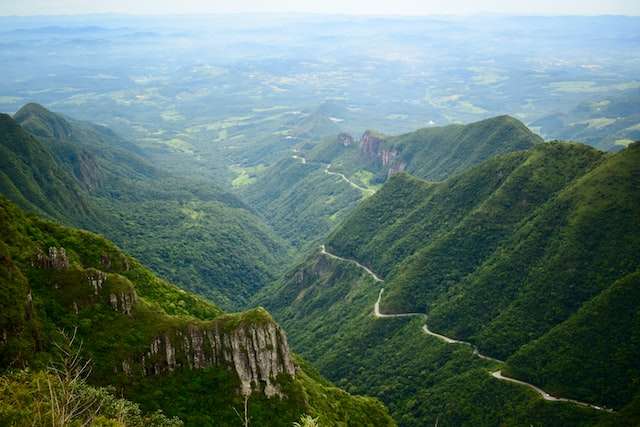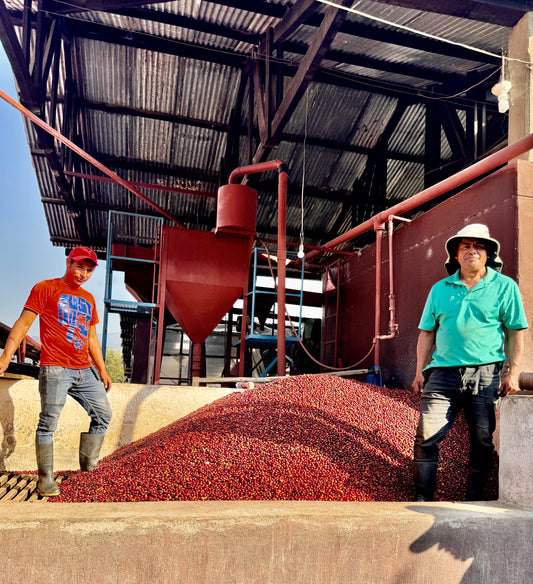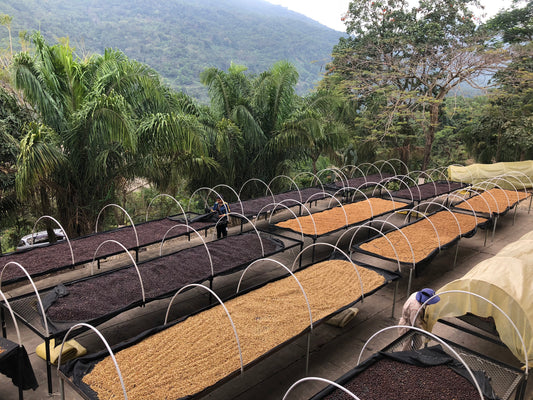High Altitude Coffee : What’s The Big Deal?

Have you ever wondered what elevation has to do with the cup of coffee you’re drinking? If you’ve ever looked at your bag of coffee and been baffled by “5200 ft”, you’re not alone. High altitude coffee is the kind of coffee you want to seek out, and elevation is one of the most important flavour factors.

Even in hot countries near the equator, pieces of land at high altitudes have cooler temperatures. A piece of land high up in the mountains will be much cooler than the land closer to sea level. Coffee trees are happiest in these lower temperatures, and that’s why you’ll find almost exclusively high elevation coffee in the specialty coffee sphere.
In this article, we’ll help you understand why high altitude coffee is so sought-after.
What is high altitude coffee?
High altitude coffee is coffee that’s been grown at a high elevation of 4000-5500 ft above sea level. High altitudes have lower temperatures, which is why many mountainous regions in hot climates tend to feel cooler than ground levels.
Growing coffee is a very long process, and it needs a consistent temperature. Coffee mainly grows in hot countries near the equator, like Ethiopia, Kenya, El Salvador and Colombia.
Ironically, coffee trees don’t like intense heat. Arabica coffee is a delicate plant. Coffee trees like the kind of weather that you and I like–20 degrees C with some shade. Comfortably warm, without the scorching sun on our skin.
In order to facilitate this paradise-like microclimate for coffee trees, producers like to grow coffee at high elevations, like in the mountains.
Why is high altitude coffee desirable?
High altitude coffee tends to have better, more complex flavour than low altitude coffee. The cooler temperatures of the high altitudes allow the coffee trees to grow slowly. This allows them to mature slower and develop complex flavours. When it comes to specialty coffee, high altitude is key.
Coffee does also grow closer to sea level. This is called low elevation coffee, and it’s widely commercially available because it’s cheap and in high supply. In general, the lower the altitude, the lower the quality of the coffee.
What is low altitude coffee?
Low altitude coffee is coffee that’s grown at an altitude of between 600 and 2500 ft above sea level. Most commercially available coffee sold around the world is low altitude coffee. It’s cheaper to produce, it grows quickly, and it has a massive yield.
However, arabica coffee (the only subspecies of coffee you’ll find in specialty coffee) doesn’t grow well in heat and direct sun. Robusta, on the other hand, loves heat and sun. That’s why most low altitude coffee is robusta.
“Sun grown coffee” is another related term that means coffee that’s grown directly in the sun. When the sun hits the coffee trees, they grow very quickly. A lot of low elevation coffee is also sun grown coffee. Direct sunlight makes the coffee grow even faster.
Low altitude and sun grown coffee are widely grown because they’re much easier to cultivate than high altitude coffee. High altitude coffee requires a lot more hard work and knowledge to produce.
Physical differences between high and low altitude coffee
An expert will be able to quickly spot the difference between high and low altitude green coffee beans. However, there are some general tell-tale signs.
High altitude coffee physical characteristics
High altitude coffee beans are harder and denser than low elevation coffee. The beans are hard because they’ve grown slowly and have had time to mature. The fissure (ie. that little line that runs down the coffee bean) says a lot about the coffee. High elevation coffee will have a fine fissure line, which is sometimes zig-zagged or askew.
Low altitude coffee physical characteristics
Low altitude coffee is a softer, less dense coffee bean. Because it grows so quickly, it doesn’t grow compactly. It has a wider fissure line than high altitude coffee, and the line is usually straight.

The difference in flavour
High altitude coffee has complex flavour and acidity. You’ll taste a lot of things going on at once, like sweetness, fruit, spices, acidity, body, bitterness, and more.
Medium altitude coffee will have some sweetness, with little to no acidity. Medium elevation coffee is somewhere between 2500 ft and 4000 ft above sea level.
Low altitude coffee will have no acidity, no sweetness, and taste bland and vegetal. People drink this coffee just to get their caffeine fix, and it tastes bearable if you like tons of sugar and cream in your coffee!
Check out Perfect Daily Grind’s elevation coffee chart to see where your coffee lies!
Can low altitude coffee be good?
In some cases, low altitude coffee can be excellent. Altitude is relative–some coffees won’t do well with high altitudes in parts of the world with already cool temperatures. Take Kona, Hawaii, for example. This low altitude coffee region produces some of the best coffee in the world. The higher altitudes in Kona would be too cold, and likely kill the coffee trees.
While high altitude coffee is certainly praised in the specialty coffee world, there’s no saying that low altitude coffee is “bad.” Specialty coffee has its own distinct culture, with its own grading system. To rate low elevation, sun grown, or robusta coffee by specialty coffee standards can often be simplistic.
Robusta coffee, which thrives in low elevations, heat, and sun, has its own culture that’s separate from specialty coffee. It’s a different subspecies of coffee, with a completely different flavour profile, making up 40% of the world’s coffee production.
There is a lot of love for robusta coffee, which contains more caffeine and is enjoyed in smaller quantities. Robusta coffee is very popular in countries like the Philippines and Vietnam, which have a huge coffee culture.
However, it’s safe to say that most commercially available coffee that’s low altitude coffee is lower quality.

Tasting the difference
If you want to find the best specialty coffee, look for coffee that’s been grown at an elevation of at least 4500 ft. To further explore the flavours of high altitude coffee, check out our previous article on coffee cupping at home.
Looking for a true elevation coffee experience? Try our high altitude coffees. Our Nicaragua is clean and creamy with notes of jasmine and black tea. Our Colombia is sweet and citrusy, with notes of caramel and honey.





